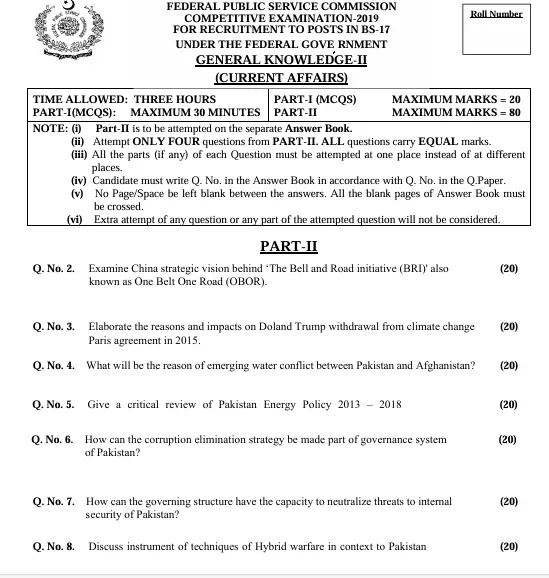Table of Contents
ToggleCSS Current Affairs Paper 2019
PART-II
Q. No. 2. Examine China’s strategic vision behind ‘The Bell and Road Initiative (BRI)’ also known as One Belt, One Road (OBOR). (20)
Q. No. 3. Elaborate on the reasons and impacts of Doland Trump’s withdrawal from the climate change Paris Agreement in 2015. (20)
Q. No. 4. What will be the reason for the emerging water conflict between Pakistan and Afghanistan? (20)
Q. No. 5. Give a critical review of Pakistan Energy Policy 2013 – 2018 (20)
Q. No. 6. How can the corruption elimination strategy be made part of the governance system of Pakistan? (20)
Q. No. 7. How can the governing structure have the capacity to neutralize threats to the internal security of Pakistan? (20)
Q. No. 8. Discuss instruments of techniques of Hybrid warfare in the context of Pakistan (20)
Summary:
Q. No. 2: Examine China’s strategic vision behind ‘The Belt and Road Initiative (BRI)’ also known as One Belt, One Road (OBOR). (20)
Strategic Vision:
- Global Connectivity: Enhance trade routes through infrastructure development across Asia, Africa, and Europe.
- Economic Growth: Boost China’s economy by creating new markets and reducing overcapacity.
- Geopolitical Influence: Strengthen ties with participating nations and counter US dominance.
- Energy Security: Secure energy supply routes through pipelines and ports (e.g., Gwadar).
- Regional Stability: Stabilize neighboring regions through economic integration.
Criticism: Debt-trap diplomacy and environmental concerns may hinder long-term success.
Q. No. 3: Elaborate on the reasons and impacts of Donald Trump’s withdrawal from the climate change Paris Agreement in 2015. (20)
Reasons:
- Economic Priorities: Fear of job losses and reduced industrial competitiveness.
- Skepticism About Climate Science: Trump administration downplayed climate change’s urgency.
- America First Policy: Viewed the agreement as unfair to the US compared to China and India.
Impacts:
- Global Leadership Void: Undermined international climate efforts.
- Domestic Backlash: States like California adopted independent green policies.
- Reputational Damage: Reduced US credibility in multilateral agreements.
Long-term Effects: The Biden administration’s re-entry reflected changing political priorities.
Q. No. 4: What will be the reason for the emerging water conflict between Pakistan and Afghanistan? (20)
Reasons for Conflict:
- Shared Water Resources: Disputes over the Kabul River basin’s usage.
- Unregulated Development: Afghanistan’s plans for dam construction (e.g., Shahtoot Dam).
- Climate Change: Reduced water availability exacerbating tensions.
- Political Relations: Lack of a water-sharing treaty worsens mistrust.
Potential Impacts:
- Agricultural Strain: Threatens Pakistan’s irrigation-dependent economy.
- Regional Instability: Escalates tensions, affecting bilateral ties.
Resolution: A binding treaty and regional cooperation on water management are crucial.
Q. No. 5: Give a critical review of Pakistan Energy Policy 2013–2018. (20)
Achievements:
- Capacity Expansion: Increased electricity generation, reducing load shedding.
- Renewable Initiatives: Focused on solar and wind energy projects.
- Private Sector Role: Promoted Independent Power Producers (IPPs).
Criticism:
- High Costs: Over-reliance on imported fuel increased production costs.
- Circular Debt: Escalated due to inefficiencies and subsidies.
- Environmental Neglect: Limited focus on sustainable and eco-friendly solutions.
Future Recommendations: Emphasis on indigenous resources, grid modernization, and policy transparency.
Q. No. 6: How can the corruption elimination strategy be made part of the governance system of Pakistan? (20)
Strategies:
- Institutional Reforms: Strengthen accountability bodies like NAB.
- Digital Governance: Minimize human intervention in service delivery to reduce bribery.
- Whistleblower Protection: Encourage reporting of corruption with safeguards.
- Judicial Efficiency: Expedite corruption cases through specialized courts.
- Public Awareness: Promote anti-corruption campaigns to instill ethical values.
Challenges: Political interference and weak enforcement mechanisms hinder effectiveness.
Q. No. 7: How can the governing structure have the capacity to neutralize threats to the internal security of Pakistan? (20)
Measures:
- Enhanced Law Enforcement: Improve police training and equip counterterrorism units.
- Intelligence Coordination: Strengthen data-sharing between agencies.
- Judicial Reforms: Swift trials for terrorism-related offenses.
- Community Engagement: Address grievances of marginalized groups to prevent radicalization.
- Border Management: Control cross-border movement of militants.
Conclusion: A proactive and integrated approach is critical to sustaining internal security.
Q. No. 8: Discuss instruments and techniques of Hybrid Warfare in the context of Pakistan. (20)
Definition: Hybrid warfare combines conventional, irregular, and cyber tactics to destabilize a target state.
Techniques Against Pakistan:
- Propaganda: Spread disinformation to create social and political unrest.
- Economic Sabotage: Target critical infrastructure (e.g., energy sector).
- Cyber Attacks: Breach sensitive data or disrupt systems.
- Proxy Warfare: Support insurgents in Balochistan and elsewhere.
- Diplomatic Isolation: Promote negative narratives on global platforms.
Response Strategies:
- Strengthen cyber defenses and counter-narratives.
- Promote internal unity through equitable policies.
- Enhance military and intelligence capabilities.
